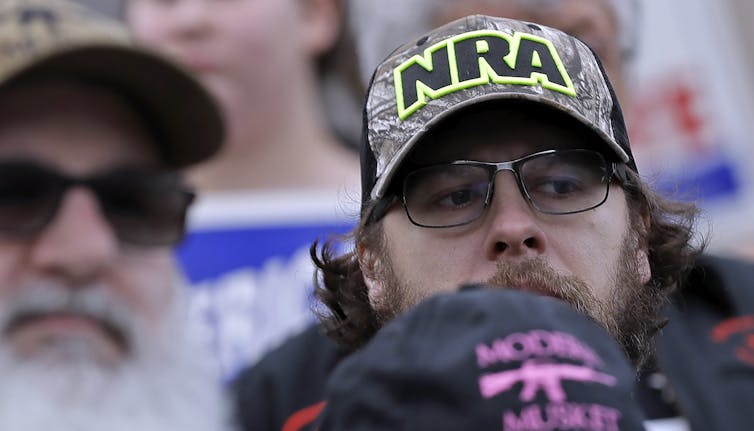Judge rejects NRA's bankruptcy bid, allowing New York's lawsuit against the gun group to proceed: 5 questions answered
- Written by Lindsey Simon, Assistant Professor of Law, University of Georgia
A federal judge in Dallas said on May 11, 2021 that he was dismissing the National Rifle Association’s bankruptcy case[1] after finding that the gun group did not file it “in good faith[2].” The NRA filed for bankruptcy[3] on Jan. 15 as a means of relocating its charter from New York, where state Attorney General Letitia James is suing the NRA[4] and four of its current and former officials, to Texas. Lindsey Simon[5], a bankruptcy scholar at the University of Georgia School of Law, explains what the repercussions might be for the gun group and its leaders.
1. What does this ruling mean?
The NRA is no longer in bankruptcy[6]. Any lawsuits or collection actions[7] that were pending before the bankruptcy, including those lodged by New York state authorities, can now resume their course.
2. How did the judge explain his rationale?
In his analysis, Judge Harlin Hale[8] followed the process required by Section 1112(b) of the U.S. Bankruptcy Code[9], the provision that addresses dismissal.
First, he looked at all available evidence, including depositions, court filings and the many days of testimony from various witnesses to determine what the NRA’s primary purpose was for filing bankruptcy[10]. Though the NRA gave a variety of different explanations, the court found that the nonprofit organization’s main driving force for filing Chapter 11 was avoiding dissolution in the pending action it faces in New York[11].
Next, Hale determined that the NRA’s use of bankruptcy to avoid dissolution was not a “good faith” filing and should be dismissed because it sought an unfair advantage in the New York litigation. Finally, he found that appointing a Chapter 11 trustee or examiner, instead of dismissing the case, was not in the best interests of the NRA’s creditors or the nonprofit itself.
In making this conclusion, Hale noted that changes the NRA has recently made[12] such as additional disclosure and reporting mechanisms show the group’s officials understand how important compliance is going forward. He also observed that the NRA has the financial means to resolve its legal and organizational issues outside of bankruptcy.
 New York state authorities accuse the NRA of financial misdeeds.
AP Photo/Ted S. Warren[13]
New York state authorities accuse the NRA of financial misdeeds.
AP Photo/Ted S. Warren[13]
3. What are the repercussions for the NRA’s leaders?
All legal actions against the NRA[14] will move forward in the jurisdiction where they were originally filed, rather than being heard by the bankruptcy court. As the NRA stated in its response[15], the organization will have to “confront its adversaries” in New York instead of Texas. To the extent bankruptcy was intended to delay the litigation process or seek a different venue, those efforts have failed.
4. Will this make a difference for anyone who says the NRA owes them money?
Yes, this ruling will allow the NRA’s creditors, including any litigants who ultimately get judgments against the NRA, to pursue the full amount they are owed against the organization, and all of the NRA’s assets will be available to pay them back. If the NRA had remained in the bankruptcy process, claims would have been settled according to the terms in a plan of reorganization[16] – which often does not pay the full amount owed. The dismissal also removes the automatic stay, which paused any collection actions[17] against the NRA while the bankruptcy case was pending. The NRA’s creditors[18] are now free to collect on debts according to non-bankruptcy law.
5. What did the public learn about the NRA from its bankruptcy case?
The bankruptcy case exposed weaknesses within the NRA’s internal management structure as well as its strategy to avoid legal exposure. Most importantly, the public learned that the NRA is solvent[19] and can afford to pay its debts.
[Over 100,000 readers rely on The Conversation’s newsletter to understand the world. Sign up today[20].]
References
- ^ dismissing the National Rifle Association’s bankruptcy case (apnews.com)
- ^ in good faith (lawandcrime.com)
- ^ NRA filed for bankruptcy (theconversation.com)
- ^ Attorney General Letitia James is suing the NRA (theconversation.com)
- ^ Lindsey Simon (papers.ssrn.com)
- ^ NRA is no longer in bankruptcy (assets.documentcloud.org)
- ^ lawsuits or collection actions (apnews.com)
- ^ Judge Harlin Hale (www.txnb.uscourts.gov)
- ^ by Section 1112(b) of the U.S. Bankruptcy Code (www.law.cornell.edu)
- ^ filing bankruptcy (theconversation.com)
- ^ pending action it faces in New York (theconversation.com)
- ^ changes the NRA has recently made (www.nraforward.org)
- ^ AP Photo/Ted S. Warren (newsroom.ap.org)
- ^ legal actions against the NRA (apnews.com)
- ^ NRA stated in its response (www.nraforward.org)
- ^ plan of reorganization (www.investopedia.com)
- ^ collection actions (nrawatch.org)
- ^ The NRA’s creditors (www.washingtonpost.com)
- ^ NRA is solvent (www.usatoday.com)
- ^ Sign up today (theconversation.com)
Authors: Lindsey Simon, Assistant Professor of Law, University of Georgia

